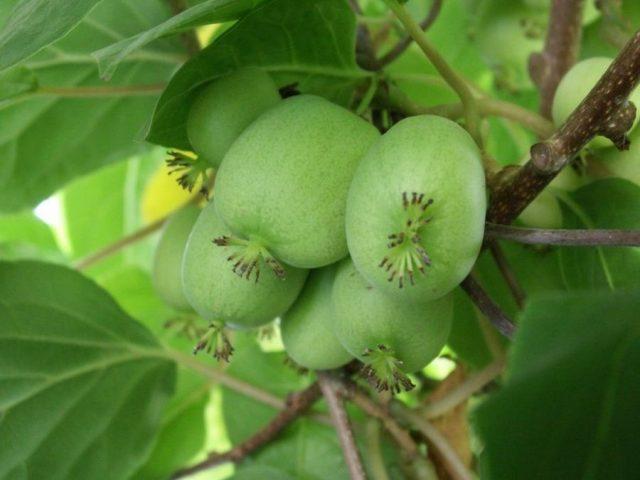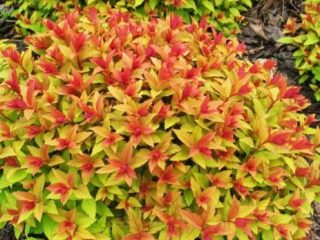Content
Actinidia Adam is a beautiful plant for the garden with edible, delicious fruits. Before planting a crop, it is worth studying its main features and requirements.
Origin
Actinidia kolomikta is a relict plant that first appeared on Earth in the Tertiary period. Found naturally in the Far East. It grows mainly on mountain slopes in coniferous and mixed forests and has high winter hardiness.
It has been present in culture since 1855. Adam is a male variety of Actinidia kolomikta, bred by Polish breeder Szczepan Marczyński. It is popular among gardeners not only due to its decorative qualities, but also due to its abundant fruiting.
Description of Actinidia Adam
Actinidia kolomikta Adam is a tall, hardy vine with thin, smooth shoots with dark brown bark. The length of the stems reaches 4 m, the plant twists around a support or around its own trunk.In decorative cultivation it is mainly used to decorate fences, gazebos and building facades.

The lifespan of actinidia kolomikta Adam is on average 30 years
A distinctive feature of the variety is the unusual changeable color of the leaves. Young plates on last year's shoots have a bright light green color. The leaves on fresh growth are bronze; during the flowering period their tips turn white. Then, as the buds wither, the plates turn first pink and then crimson. Actinidia Adam looks very attractive in the garden throughout the year.
Flowers
Actinidia Adam begins to bloom for the first time only in the third year after planting. The buds are of the male type, up to 2 cm in diameter. The flowers are white and emit a pleasant aroma with citrus notes.
The buds of the plant are collected in small shields of 2-3 pieces. They appear on shoots in May and usually remain decorative for 25 days.
Fruit
Fruits on the shoots of Actinidia kolomikta appear on average 55-60 days after flowering. The harvest is fully ripe by the end of August. The fruits of the plant are dark green, oval, elongated, reaching 3 cm in length.
Externally, the berries are very similar to gooseberries; stripes are visible on the skin. The pulp of the fruit is tender and juicy, with numerous small seeds. Actinidia Adam berries taste sweetish with a refreshing sourness.

Actinidia kolomikta berries have a pleasant pineapple aroma
Where does Actinidia Adam grow?
Male actinidia Adam is capable of growing not only in the Far East, but also in other regions. The culture is grown in the Moscow region and in Siberia, Primorye and Sakhalin.The plant tolerates unfavorable climates well, survives even severe cold and calmly reacts to short-term drought.
Frost resistance of Actinidia Adam
Actinidia kolomikta has very high frost resistance. In open ground, the plant can withstand cold temperatures down to -45 C. In this case, annual shoots can freeze slightly, but in the spring the bush quickly recovers.
What soils does Actinidia Adam prefer?
Actinidia Adam grows well in fertile soil. The structure of the soil should be light and loose, without a large amount of clay. Slightly acidic soil is best suited for shrubs.
Application of Actinidia Adam fruits
The edible berries of Actinidia Adam are actively used in cooking. They are consumed fresh and processed to make compotes, preserves and jams. The fruits contain many vitamins and organic acids, strengthen the immune system and improve digestion.
Advantages and disadvantages
Actinidia kolomikta Adam has numerous advantages. The variety is valued for its decorative leaf color and high frost resistance.

Actinidia Adam contains about 1000 mg of vitamin C per 100 g of fruit
Pros:
- good yield;
- highly decorative;
- frost resistance;
- pleasant taste of fruits;
- high immunity.
Minuses:
- small-sized fruits;
- uneven ripening;
- the berries quickly fall to the ground;
- The plant requires a garter to support.
Landing rules
The plant is planted in well-lit areas, sheltered from the wind, located away from groundwater. The selected place is first dug up, sand and humus, as well as superphosphate and wood ash are added to the soil.
Direct planting of a crop on a site is carried out as follows:
- Dig a hole about 50 cm deep.
- Place a drainage pad up to 10 cm thick on the bottom of the hole.
- Fill the hole halfway with a substrate made from a mixture of earth, humus and sand.
- Place the seedling in the center of the hole and straighten the roots to the sides.
- Cover the actinidia with soil and water it abundantly.
After planting, the vine is tied to an installed support. The root collar is left flush with the ground surface.
Care instructions
Growing ornamental shrubs on the site is quite easy. Attention needs to be paid to several points.
Trimming
The shrub produces berries on both fruiting and mixed branches. Therefore, the plant requires gentle pruning, otherwise the yield will be greatly reduced.
The first pruning of the shrub is carried out in the second year after planting. The algorithm looks like this:
- All branches of the plant are cut off, except for the 3-4 most powerful shoots.
- The remaining vines are shortened to 40 cm.
- The next year, the skeletal branches are pruned to 1/3.
Every year the crown of the shrub is thinned out to prevent thickening. The height of the plant is maintained at 1.7 m, diameter - within 2.4 m.
Watering and fertilizing
The shrub loves moisture, so it needs to be watered at least once a week in dry weather. When there is a lack of water, the plant sheds its leaves and fruit ripening slows down.
At the same time, it is impossible to waterlog the soil at the roots of the bush. If the soil has not yet dried out, watering should be avoided, especially during periods of heavy rain.

When watering one adult shrub, actinidia consume 60-70 liters of water
To get a good harvest, the shrub needs to be fed regularly. Fertilize the plant three times per season:
- in spring - urea or infusion of chicken manure;
- when ovaries appear, use mullein solution;
- in autumn - complex minerals with phosphorus and potassium.
Before applying fertilizers, it is recommended to moisten the soil thoroughly with plain water.
Wintering
Actinidia Adam tolerates winter cold well with minimal insulation. With the onset of autumn, it is necessary to carry out sanitary pruning for the bush. After this, the vines are removed from the support, placed on an insulating cushion of spruce branches and covered with a thick layer of dry foliage. After snow falls, a snowdrift can be formed over the plant.
Disease and pest control
If not properly cared for, the shrub may suffer from fungi and pests. The threat to him is:
- rot - a fluffy light coating appears on the shoots and fruits of the plant, the berries become flabby and darken, actinidia eventually dies;
Rot appears in conditions of high humidity and at temperatures below 18 ° C
- ramularia - light brown spots form on the leaves of the plant on both sides;
In case of ramularia, the affected parts of the bush need to be cut off, and healthy parts should be treated with Bordeaux mixture
- leaf beetles - pests feed on buds and young plates, eating them down to the veins.
Actinidia can be sprayed against leaf beetles with Iskra and Aktara
To prevent the bush from suffering from fungus, it is necessary to regularly thin out its crown and monitor the soil moisture. Diseases develop mainly in swampy soil.
Reproduction
Actinidia kolomikta Adam can be propagated in two ways:
- Seeds. In early spring, the plant is sown as seedlings in home containers. The resulting shoots are watered and, if necessary, supplemented with light; the stronger shoots are transplanted into the ground in June.
- Cuttings. From a two-year-old side branch of the vine, several shoots with 3-4 buds are cut and put in a warm place in a damp cloth for a week. After the roots appear, the cuttings are planted in loose peat soil.
Most often, the vegetative method is used for propagation. In this case, the shrub develops faster and begins to bear fruit earlier.
Conclusion
Actinidia Adam is a fruit crop for the garden with high decorative properties. The main distinguishing feature of the variety is its variegated leaves.
Reviews of Actinidia Adam











